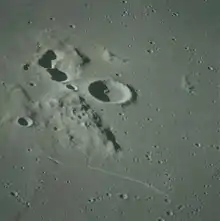Lassell (lunar crater)
Lassell is a small lunar impact crater that is located in the eastern part of the Mare Nubium. It was named after British astronomer William Lassell.[1] It lies to the west of the crater Alpetragius and southwest of Alphonsus.


 Lunar Orbiter 4 image | |
| Coordinates | 15.5°S 7.9°W |
|---|---|
| Diameter | 23 km |
| Depth | 0.9 km |
| Colongitude | 8° at sunrise |
| Eponym | William Lassell |
Description
The interior of Lassell has been flooded and resurfaced by lava, leaving a nearly flat surface with a low remaining outer rim. The surface has a low albedo, giving the interior a dark appearance. The surviving outer wall is generally circular but with a somewhat polygonal shape.
To the east-northeast is a circular, bowl-shaped crater designated Lassell B. This formation has a higher albedo than its surroundings and so appears relatively bright, especially at high sun angles.
The tiny crater Lassell D is located to the west-northwest of Lassell, about halfway to the ruined crater Guericke. This craterlet is surrounded by a patch of high-albedo surface, and is an example of a prominent lunar bright patch. The light hue is thought to be an indication of recent formation, at least in lunar geological terms.
To the west of Lassell is a small highland area called the Lassell Massif, which has a reddish color relative to the surrounding mare.[2]
Satellite craters
By convention these features are identified on lunar maps by placing the letter on the side of the crater midpoint that is closest to Lassell.
| Lassell | Latitude | Longitude | Diameter |
|---|---|---|---|
| A | 16.8° S | 6.8° W | 3 km |
| B | 16.1° S | 7.7° W | 4 km |
| C | 14.7° S | 9.3° W | 9 km |
| D | 14.5° S | 10.5° W | 2 km |
| E | 18.2° S | 10.2° W | 5 km |
| F | 17.1° S | 12.5° W | 5 km |
| G | 14.8° S | 9.0° W | 7 km |
| H | 14.5° S | 11.2° W | 5 km |
| J | 14.8° S | 10.4° W | 4 km |
| K | 15.1° S | 8.9° W | 4 km |
| M | 14.2° S | 8.8° W | 3 km |
| S | 18.2° S | 8.5° W | 4 km |
| T | 17.1° S | 8.8° W | 2 km |
References
- "Lassell (lunar crater)". Gazetteer of Planetary Nomenclature. USGS Astrogeology Research Program.
- Color of the Lassell Massif, Lunar Reconnaissance Orbiter article by J. D. Stopar, September 12, 2016
- Andersson, L. E.; Whitaker, E. A. (1982). NASA Catalogue of Lunar Nomenclature. NASA RP-1097.CS1 maint: ref=harv (link)
- Bussey, B.; Spudis, P. (2004). The Clementine Atlas of the Moon. New York: Cambridge University Press. ISBN 978-0-521-81528-4.CS1 maint: ref=harv (link)
- Cocks, Elijah E.; Cocks, Josiah C. (1995). Who's Who on the Moon: A Biographical Dictionary of Lunar Nomenclature. Tudor Publishers. ISBN 978-0-936389-27-1.CS1 maint: ref=harv (link)
- McDowell, Jonathan (July 15, 2007). "Lunar Nomenclature". Jonathan's Space Report. Retrieved 2007-10-24.CS1 maint: ref=harv (link)
- Menzel, D. H.; Minnaert, M.; Levin, B.; Dollfus, A.; Bell, B. (1971). "Report on Lunar Nomenclature by the Working Group of Commission 17 of the IAU". Space Science Reviews. 12 (2): 136–186. Bibcode:1971SSRv...12..136M. doi:10.1007/BF00171763.CS1 maint: ref=harv (link)
- Moore, Patrick (2001). On the Moon. Sterling Publishing Co. ISBN 978-0-304-35469-6.CS1 maint: ref=harv (link)
- Price, Fred W. (1988). The Moon Observer's Handbook. Cambridge University Press. ISBN 978-0-521-33500-3.CS1 maint: ref=harv (link)
- Rükl, Antonín (1990). Atlas of the Moon. Kalmbach Books. ISBN 978-0-913135-17-4.CS1 maint: ref=harv (link)
- Webb, Rev. T. W. (1962). Celestial Objects for Common Telescopes (6th revised ed.). Dover. ISBN 978-0-486-20917-3.CS1 maint: ref=harv (link)
- Whitaker, Ewen A. (1999). Mapping and Naming the Moon. Cambridge University Press. ISBN 978-0-521-62248-6.CS1 maint: ref=harv (link)
- Wlasuk, Peter T. (2000). Observing the Moon. Springer. ISBN 978-1-85233-193-1.CS1 maint: ref=harv (link)
External links
| Wikimedia Commons has media related to Lassell (lunar crater). |
- Lassell at The Moon Wiki
- Wood, Chuck (February 13, 2007). "New Observations of a Well-Known Area". Lunar Photo of the Day. Archived from the original on June 14, 2011.
- Wood, Chuck (January 31, 2010). "Spotted Moon". Lunar Photo of the Day.
.jpg.webp)